![]()
![]()
![]()
Use LEFT and RIGHT arrow keys to navigate between flashcards;
Use UP and DOWN arrow keys to flip the card;
H to show hint;
A reads text to speech;
19 Cards in this Set
- Front
- Back
|
Gekkonidae- gecko lizards
Flattened bodies, short limbs. Expanded toe pads may have hairlike bristles w/ minute suction cups. Most vocal lizards. Found in texas, california, and florida. |
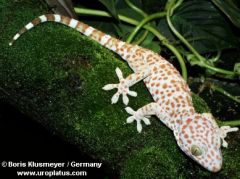
Identify
|
|
|
Polychridae anolis anoles
Found in tropics in bolivia and paraguay, and the green anole in the southeast US. Flap of skin on throat extending to the chest called a throat fan. Can change color to brown grey and green. Eats insects and spiders. |
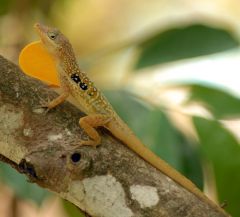
Identify
|
|
|
Iguanidae-iguana-green iguana
enlarged round smooth dark edged scale on each side of the throat below ear opening. green brown tan gray w/ dark bands on shoulder + tail. fleshy spines on tail + back. Tall trees w/ dense canopies near water, or open areas. Florida NM and into south america. Eats flowers fruits insects, sm. vertebrates, carrion. |
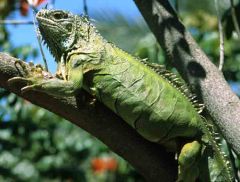
Identify
|
|
|
iguanidae-dipsosaurus-desert iguana blunt medium-sized lizard. Including the tail, these blunt-headed lizards typically grow to 16" (40 cm).Their preferred habitat is largely contained within the range of the creosote bush, mainly dry, sandy desert scrubland below 3300 ft. It can also be found in rocky streambeds up to 3300 ft. In the southern portion of its range this lizard lives in areas of arid subtropical scrub and tropical deciduous forest. They are pale gray-tan to cream in color with a light brown reticulated pattern on their backs and sides. Down the center of the back is a row of slightly-enlarged, keeled dorsal scales that become slightly larger as you move down the back. The reticulated pattern gives way to brown spots near the back legs, turning into stripes along the tail. The tail is usually around 1 1/2 times longer than the body from snout to vent. The belly is pale. During the breeding season, the sides become pinkish in both sexes.
|

identify
|
|
|
iguanidae-sauromalus-chuckwalla
found primarily in arid regions of the southwestern United States and northern Mexico in lava flows. females and the immature have bodies with scattered spots or contrasting bands of light and dark in shades of gray or yellow. wide, flattened midsections and prominent paunch. Their tails are also notably thick, tapering to a blunt tip. Loose folds of skin characterize the neck and sides of the body, which is covered in small, coarsely granular scales. males having reddish to orange, yellow or light gray bodies and black heads, shoulders and limbs, females have bodies with scattered spots or contrasting bands of light and dark in shades of gray or yellow. feed on leaves, fruit and flowers. |
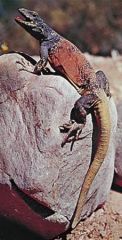
identify
|
|
|
crotaphytidae-collared lizard
black and white collar areas across back of neck. inside of mouth is dark. yelow-brown to green, w/ bluish highlights,light spots, and dark bands. male has blue/green/orange throat, female has red-orange spots and bars on sides. Hardwood forests to arid areas, hillly regions, or limestone ledges w/ rocks. Eats lizards and insects. |
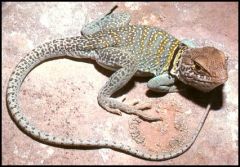
identify
|
|
|
phrynosomatidae-sceloporus-spiny lizards
keeled and pointed dorsal scales, eat insects, baby mice, and smaller lizards, has blue patch on at each side on the belly and throat. Found in roch outcrops and rotting stumps. Found in texas, california, new mexico, and mexico and arizona. |

identify
|
|
|
phrynosomatidae-cophosaurus-earless lizards
two folds across throat, no external ear, long tail w/ no spots, female is paler then male. male has black marks on side of belly. lives on sand dunes and barrier beaches in southern texas and into mexico. is gray to brownish . |
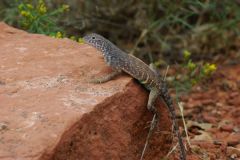
identify
|
|
|
phrynosomatidae-holbrookia-earless lizards
Earless lizards are found from the southwestern and central United States, in the states of Texas, Arizona, New Mexico, Utah, Colorado, Kansas, Oklahoma, and as far north as Nebraska, South Dakota, and Wyoming. They are also found in Mexico. no external ear openings, presumably to prevent sand from entering the body as they dig. |
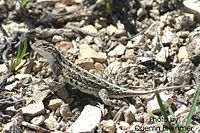
identify
|
|
|
phrymosomatidae-uma-fringe toed lizards
brown and tan coloration that helps them to blend in with the sand. have special scales which form a fringe on the sides of their toes. These fringes aid with traction, speed and help the lizard avoid sinking into loose, sandy dunes. upper jaw which overlaps the lower, preventing the intrusion of sand particles, and nostrils that can be closed at will. Flaps close against the ear openings when moving through sand and the upper and lower eyelids have interlocking scales that prevent sand from getting into the eyes.RANGE- southeast California and southwest Arizona, extend into northwest Sonora and northeast Baja California in low desert areas having fine, loose sand. Eats insects: ants, beetles, grasshoppers, and caterpillars and flower buds, stems, leaves and seeds of plants. |

identify
|
|
|
phrynosomatidae-urosaurus-tree and side blotched lizards
tree lizard- small gray or gray brown. back has irregular dark spots or crossbands w/blue. fold of skin across throat. folds of skin on each side of the body. throat is yellow or pale orange. trees, rocks, stone, cinder block walls, texas to california, north to utah, wyoming, mexico, sinaloa. side blotched lizard- blue-spangled back, one black sport posterior to the armpit. Brown, striped/spotted/blue flecks. yellow/pale orange-brown spots on the sides. middorsal scales keeled and larger then the small scales on the side of the body. Desert flats and foothills. washington to california and mexico, texs, n.mexico, arizona. |
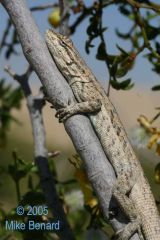
identify
|
|
|
phrynosomatidae-uta-tree and side blotched lizards. A small lizard w/small back scales, single dark blue to black spot on side behind foreleg. Arid and semi arid regions, gravily soil low growing vegitation. C Washington Oregon to w. Texas Mex west to pacific coast and baja
|

Identify
|
|
|
phrynosomatidae-phrynosoma-horned lizards. Frimged scales one or two rows, Horns Colors- reddish yellowish greyish tan. South west region texas Mex OOklahoma, Kansas, New Mexico
|
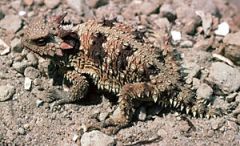
identify
|
|
|
lacertidae-wall lizard. Small slender lizard, dorsum of body cover w/ fine grandular scales that are brown to gray. A row a dark mid dorsal spots which is sometimes a stip. BRown grey or red tail. Bellie has 6 rows of rectang scales, that are white reddish, pink or orange. Range- Ohio river Ohio. Likes crumbling rock walls and piles or debree. eat s insects.
|

identify
|
|
|
teiidae-cnemidophorus-racerunners and whiptails. WHIPTAILS-Long tails, 1000s of tiny scales on their backs, 8 row of large rectangular scales on there bellies. Eat mostly insects bt also spider scorpians and small arthropods. West indies central south america.
RACERUNNERS- strips (six) yellow white, pale grey ore blue. Short dark strip on one side of the tail dark area of brown greenish brown and sometimes black. Prairie Racerunner 7 strips and they are bright green, Range- Southern central united states east to west up to wisconsin |
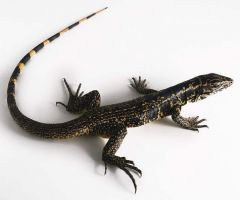
identify
|
|
|
scincidae-eumeces-skink
smooth and shiny, tails break off easily. Fat snakes with legs strips and variations. range- Texas east and up to michigan. Found in debree decaying logs and swamps. Eats insects, baby mice or bird and eggs. |

identify
|
|
|
anguidae-ophisaurus-glass lizard(legless) eyelids and external ear openings, white markings in centre of back scale, groove along the sides, can be dark strips or spec. below groove. Sometimes dark strip down the middle of the back. Range- Fla to virginia and west to texas, kansas up to illinois. Found dry grass some in damp grass, open wood lands.
|
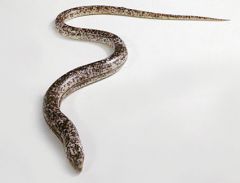
identify
|
|
|
angidae-gerrhonotus-alligator lizard scales large and plate like. Color is reddish brown broken light lines across back and tail. Only lizard with lateral groove and legs. Flexible groove from neck to hind leg. Eats insects spiders new born mice small snakes and lizards. Range - central Mexico and centra Texas.
|
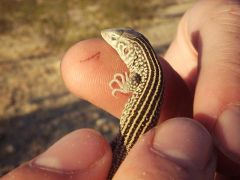
identify
|
|
|
helodermatidae-gila monster XX
large and heavy bodied, small bead like scales on teh back, broken bloctcheds bars spots of black and yellow organge or pink w/ bands on the blunt tails Black Face. Foundin in arid or semi arid area of gravely or sandy soils w/ saome shrubs and moisture. Found under rock and burrows. Range- Bottom of Utah Nevade central arizona and little bit in to mexico. |
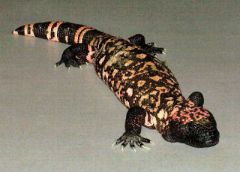
identify
|

